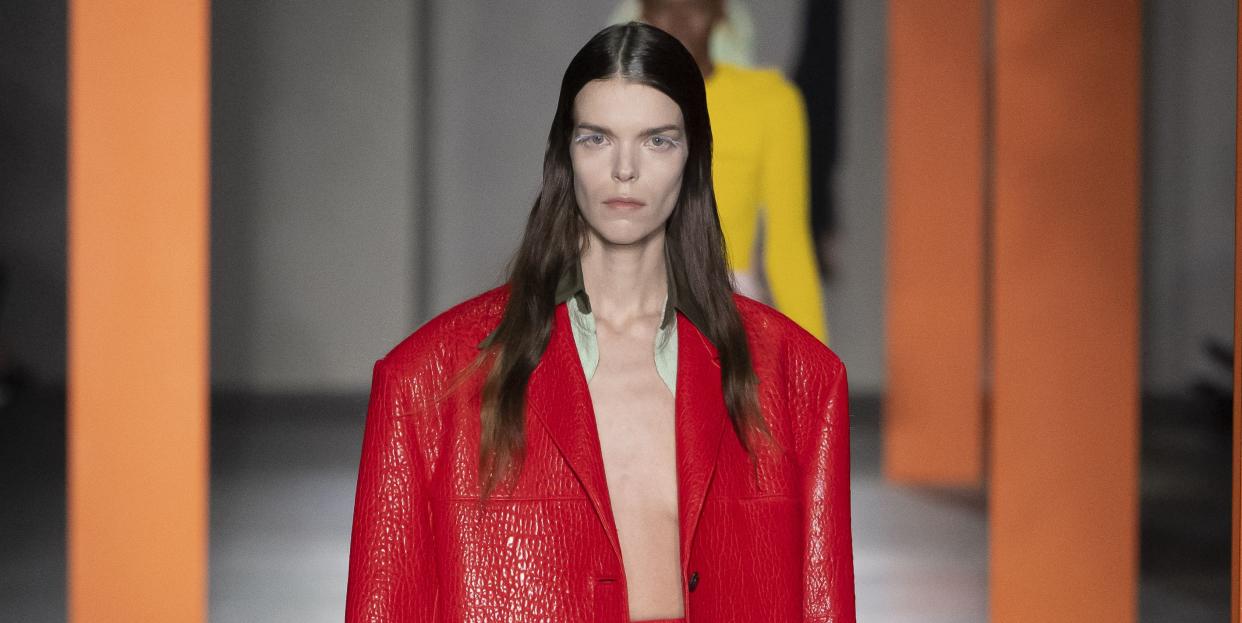Prada Fights Glamour, Welcomes Beauty

- Oops!Something went wrong.Please try again later.
Thursday’s Prada show was an absolute smash—probably the loveliest and most exciting collection that Mrs. Prada and Raf Simons have shown since he joined her for their first-of-its-kind collaborative partnership as co-creative directors three years ago.
Nearly every piece was desirable, from the kitten-heel flats with paper crane-like adornments and wedding dress-inspired full and pencil skirts gingerly dotted with the most delicate doilies of lace, to the vernacular coats—toggle, military, etc.—cut bulbous at the top and fitted through the hip like a 1930s Hollywood gown, or a Balenciaga dress for one of Cristobal’s most discerning clients. There were cape coats, and beautiful silk dresses draped with ease and finishing with that rectangular hem Simons and Mrs. Prada have been playing with since Spring 2022 (and it’s finally really working). The collection was loaded with couture techniques applied at the most luxuriant and empathetic level, which is in the service of making clothes not for special occasions, but for everyday life.
A number of white skinny dresses in a sturdy cotton twill were inspired by nurse uniforms, starchy and somehow both humble and imperious. (I think that’s the power of pockets, especially on a dress. You can’t be dignified and relaxed without pockets.) In a statement released with the show notes, Simons said that “the idea of beauty we were drawn to was synonymous with the idea of caring, the idea of taking care, and the uniforms associated with that.” When many fashion shows seem to exist as a sheer defiance that the pandemic ever happened, Simons and Mrs. Prada are still thinking fondly of the people who got us through. Perhaps because they’re also thinking about how far they’ve come since their relationship at Prada began, right when COVID began surging in Europe, and how the world of beautiful stuff is possible again only because of those who cared enough, and as a profession, to pull us through.
Beauty is a new word for Prada, and it’s one Mrs. Prada used as well: “There is the notion in fashion that only glamour is important, I hate that, I have always fought against that,” she said. “This collection is about finding beauty everywhere, beauty of different kinds.”
That may shock people who have long known Prada for turning ugly into something chic, although I would argue that this collection had its fair share of classic Prada dowdiness, especially in the pairing of the big full skirts—so charming and pert—with oversized crewneck Shetland wool sweaters, and the big beefy leather blazers worn with the clingiest pencil skirts.
The collection reminded me of two periods in particular. The 1930s, in those beautifully shaped coats and a handful of printed silk dresses fitted through the hip that spilled out into a flippy train, like streamlined takes on an Adrian Greenburg or Jeanne Lanvin’s understated silk gowns from the beginning of that decade. (Great Oscar dresses.) And then the very late 1950s and early 1960s, with the pencil skirts that reached to the mid-calf and high-waisted pedal pusher pants, worn with boxy jackets or little sweaters and flat shoes. And that great old lady bag, with its gold metal frame. It’s the kind you open and find a Bvlgari ring you thought you lost between two Werther’s Originals.
What those two periods in fashion history share, to my mind, is a commitment to beauty even as the world was sputtering into chaos. The Museum at FIT had a great exhibition about this in 2014, in fact, called “Elegance In an Age of Crisis” (which sums up this Prada collection well!). I’m also thinking of Schiaparelli turning the grotesque into something fabulous in ’30s Paris, a dare for the most avant-garde women alive. Prada pulled the reverse move by putting wedding dress embroideries and embellishments on daywear, including pencil and miniskirts. Or Eva Saint Marie at the end of Hitchcock’s North By Northwest, from 1959, clinging to the face of Mount Rushmore for dear life, but still hanging on to her boxy little handbag.
Here is another option beyond elevating yourself above the ugliness that has overtaken everyday life: refusing in terrible times to let your standards for beauty and care—of yourself and most importantly of others—slip. This collection was a manifesto of inventive poise.
You Might Also Like

